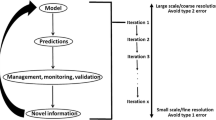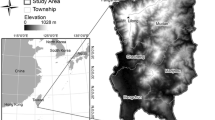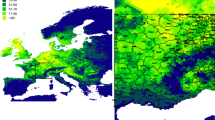Abstract
Invasive species, biological control and climate change are driving demand for tools to estimate species’ potential ranges in new environments. Flawed results from some tools are being used to inform policy and management in these fields. Independent validation of models is urgently needed so we compare the performance of the ubiquitous, logistic regression and the CLIMEX model in predicting recent range extensions of the livestock tick, Rhipicephalus (Boophilus) microplus, in Africa. Both models have been applied to the tick so new, independent data can be used to test their ability to model non-equilibrium distributions. Logistical regression described the spatial data well but failed to predict the range extensions. CLIMEX correctly predicted the extensions without fitting the non-equilibrium data accurately. Our results question the validity of using descriptive, statistical models to predict changes in species ranges with translocation and climate change. More test cases that include independent validation are needed.


Similar content being viewed by others
References
Anderson RP, Lew D (2003) Evaluating predictive models of species’ distributions: criteria for selecting optimal models. Ecol Modell 162:211–232
Austin MP, Meyers JA (1996) Current approaches to modelling the environment niche of eucalypts: implication for management of forest biodiversity. For Ecol Manag 85:95–106
Beaumont LJ, Hughes L (2002) Potential changes in the distribution of latitudenally restricted Australian butterfly species in response to climate change. Glob Chang Biol 8:954–971
Bruce D, Wilson A (1998) The extensive spread of heartwater in Zimbabwe since 1975. In: Coons L, Rothschild M (eds) The second international conference on tick-borne pathogens at the host-vector interface: a global perspective, August 28–September 1 1995, Kruger National Park, South Africa, S.I. The Conference, pp 105–112
Cumming GS (1999a) The evolutionary ecology of African ticks. Oxford University, Oxford
Cumming GS (1999b) Host distributions do not limit the species ranges of most African ticks (Acari: Ixodida [Metastigmata]). Bull Entomol Res 89:303–327
Cumming GS (2000a) Using between-model comparisons to fine-tune linear models of species ranges. J Biogeogr 27:441–455
Cumming GS (2000b) Using habitat models to map diversity: Pan-African species richness of ticks (Acari: Ixodida). J Biogeogr 27:425–440
Cumming GS (2002) Comparing climate and vegetation as limiting factors for species ranges of African ticks. Ecology 83:255–268
Elith J, Graham CH et al (2006) Novel methods improve prediction of species’ distributions from occurrence data. Ecography 29(2):129–151
Estrada-Pena A (2001) Climate warming and changes in habitat suitability for Boophilus microplus (Acari: Ixodidae) in Central America. J Parasitol 87(5):978–987
Estrada-Pena A, Corson M et al (2006) Changes in climate and habitat suitability for the cattle tick Boophilus microplus in its southern Neotropical distribution range. J Vector Ecol 31(1):158–167
Guisan A, Thuiller W (2007) Predicting species distribution: offering more than simple habitat models (vol 8, pg 993, 2005). Ecol Lett 10(5):435
Hall M, Wall R (1995) Myiasis of humans and domestic animals. Adv Parasitol 35:257–334
Holt RD, Keitt TH (2005) Species’ borders: a unifying theme in ecology. Oikos 108(1):3–6
Hoogstraal H (1956) Ticks of the Sudan. US NAMRU No 3, Cairo
IPCC (2007) Climate change 2007: synthesis report. Cambridge University Press
Kriticos DJ, Randall PR (2001) A comparison of systems to analyse potential weed distributions. In: Groves RH, Panetta FD, Virtue JG (eds) Weed risk assessment. CSIRO, Melbourne, pp 61–79
Lindsay SW, Parson L et al (1998) Mapping the ranges and relative abundance of the two principal African malaria vectors, Anopheles gambiae sensu stricto and An. arabiensis, using climate data. Proc R Soc Lond B 265:847–853
Lynen G, Zeman P et al (2008) Shifts in the distributional ranges of Boophilus ticks in Tanzania: evidence that a parapatric boundary between Boophilus microplus and B. decoloratus follows climate gradients. Exp Appl Acarol 44:147–164
Madder M, Thys E et al (2007) Boophilus microplus ticks found in West Africa. Exp Appl Acarol 43:233–234
Midgley GF, Hannah L et al (2002) Assessing the vulnerability of species richness to anthropogenic climate change in a biodiversity hotspot. Glob Ecol Biogeogr 11:445–451
Miller A (2002) Subset selection in regression. CRC Press (Chapman & Hall), London
Minjauw B, Robinson T et al (2001) Map of Anaplasmosis and Babesiosis in sub-Saharan Africa. ILRI, Nairobi
Mooney HA, Hobbs RJ (2000) Invasive species in a changing world. Island Press, Corelo
New M, Lister D et al (2002) A high-resolution data set of surface climate over global land areas. Clim Res 21:1–25
Peterson AT (2003) Predicting the geography of species’ invasions via ecological niche modeling. Q Rev Biol 78:419–433
Pearson RG, Dawson TP et al (2002) SPECIES: a spatial evaluation of climate impact on the envelope of species. Ecol Modell 154:289–300
Robertson MP, Peter CI et al (2003) Comparing models for predicting species’ potential distributions: a case study using correlative and mechanistic predictive modelling techniques. Ecol Modell 16:153–167
Robinson TP, Rogers DJ et al (1997) Mapping tsetse habitat suitability in the common fly belt of southern Africa using multivariate analysis of climate and remotely sensed vegetation data. Med Vet Entomol 11:235–245
Rogers DJ (1995) Remote sensing and the changing distribution of tsetse flies in Africa. In: Harrington R, Stork NE (eds) Insects in a changing environment. Academic Press, London, pp 177–193
Rogers DJ, Packer MJ (1993) Vector-borne diseases, models, and global change. Lancet 342:1282–1284
Rogers KJ, Randolph SE (1993) Distribution of tsetse and ticks in Africa: past, present and future. Parasitol Today 9(7):266–271
Rogers DJ, Randolph SE (2000) The global spread of malaria in a future, warmer world. Science 289:1763–1766
Rogers DJ, Hay SI et al (1996) Predicting the distribution of tsetse flies in West Africa using temporal Fourier processed meteorological satellite data. Ann Trop Med Parasitol 90(3):225–241
Sutherst RW (1987a) The dynamics of hybrid zones between tick (Acari) species. Int J Parasitol 17:921–926
Sutherst RW (1987b) The role of models in tick control. In: Hughes KL (ed) Proceedings of the international conference on veterinary preventive medicine and animal production. Australian Veterinary Association, Melbourne, pp 32–37
Sutherst RW (1998) Implications of global change and climate variability for vector-borne diseases: generic approaches to impact assessments. Int J Parasitol 28:935–945
Sutherst RW (2003) Prediction of species geographical ranges. Guest editorial. J Biogeogr 30:1–12
Sutherst RW (2004) Global change and human vulnerability to vector-borne diseases. Clin Microbiol Rev 17(1):136–173
Sutherst RW, Maywald GF (1985) A computerised system for matching climates in ecology. Agric Ecosyst Environ 13(3–4):281–300
Sutherst RW, Maywald G (2005) A climate-model of the red imported fire ant, Solenopsis invicta Buren (Hymenoptera: Formicidae): implications for invasion of new regions, particularly Oceania. Environ Entomol 34:317–335
Sutherst RW, Maywald GF et al (1995) Predicting insect distributions in a changing climate. In: Harrington R, Stork NE (eds) Insects in a changing environment. Academic Press, London, pp 59–91
Sutherst RW, Maywald GF et al (2007) Including species-interactions in risk assessments for global change. Glob Chang Biol 13(9):1843–1859
Theiler G (1943) “Notes on the ticks off domestic stock from Portuguese East Africa.” Estação anti-malárica de Lourenço Marques: 1–55
Theiler G (1949) Zoological survey of the union of South Africa. Tick survey: part II. Distribution of Boophilus (Palpoboophilus) decoloratus, the blue tick. Onderstepoort J Vet Sci Anim Ind 22:255–268
Thomas D, Cameron A et al (2004) Extinction risk from climate change. Nature 427:145–148
Thuiller W (2003) Biomod-optimizing predictions of species distributions and projecting potential future shifts under global change. Glob Chang Biol 9(10):1353–1362
Tønnesen MH, Penzhorn BL et al (2004) Displacement of Boophilus decoloratus by Boophilus microplus in the Soutpansberg Region, Limpopo Province, South Africa. Exp Appl Acarol 32:199–208
Wharton RH (1974) The current status and prospects for the control of ixodid ticks with special emphasis on Boophilus microplus. Bulletin de l’Office International des Epizooties 81:65–85
Zeman P, Lynen G (2006) Evaluation of four modelling techniques to predict the potential distribution of ticks using indigenous cattle infestations as calibration data. Exp Appl Acarol 39:163–176
Acknowledgements
Dr. Warwick Bottomley assisted with operation of Arcview and Dr. Graeme Cumming provided access to his database of tick distribution records and granted permission to reproduce two of his maps.
Author information
Authors and Affiliations
Corresponding author
Rights and permissions
About this article
Cite this article
Sutherst, R.W., Bourne, A.S. Modelling non-equilibrium distributions of invasive species: a tale of two modelling paradigms. Biol Invasions 11, 1231–1237 (2009). https://doi.org/10.1007/s10530-008-9335-x
Received:
Accepted:
Published:
Issue Date:
DOI: https://doi.org/10.1007/s10530-008-9335-x




